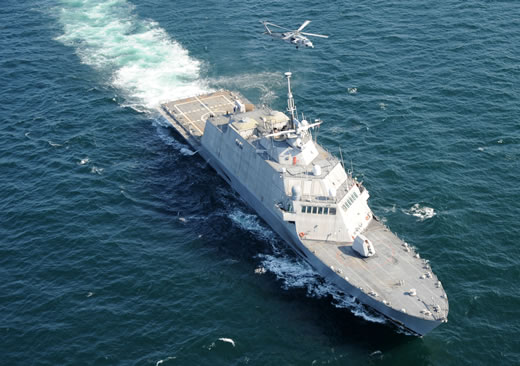
The U.S. Navy has awarded two fixed-price incentive contracts worth over US$460 million each to Lockheed Martin Corp. and Austal USA, for the design and construction of a total of 20 littoral combat ships split equally between the two companies in the next five years. The new contracts give each shipbuilding team one ship to build now, with another in 2011. In 2012, 2013, 2014 and 2015 each team will be funded to build two ships per year. Two vessels are already nearing completion.

The LCS 3 was launched earlier in December and the LCS 4 is also in construction, aiming at mid 2011 launch. “The awards represent a unique and valuable opportunity to lock in the benefits of competition and provide needed ships to our fleet in a timely and extraordinarily cost effective manner,” said Secretary of the Navy Ray Mabus. The average cost of both variants including government-furnished equipment and margin for potential cost growth across the five year period is $440 million per ship. The pricing for these ships falls well below the escalated average Congressional cost cap of $538 million.
Lockheed Martin received $436,852,639 in fiscal 2010 budget for the Freedom Class LCS while Austal USA received $432,069,883 for Independent Class vessels. Both contracts also include line items for nine additional ships, subject to Congressional appropriation in the Littoral Combat Ship (LCS) Program appropriations in each of the next four years. When all 10 ships of each block buy are awarded, the value of the ship construction portion of the two contracts would be over $3.6 billion for Lockheed Martin Corp., and over $3.5 billion for Austal USA.

The Navy plans to field 55 LCS vessels to fill critical, urgent warfighting requirements gaps that exist today, primarily to establish and maintain dominance in the littorals and sea lanes of communication choke points around the world. Chief of Naval Operations Adm. Gary Roughead praised the Navy’s plan to add both ship designs to the fleet: “The LCS is uniquely designed to win against 21st century threats in coastal waters posed by increasingly capable submarines, mines and swarming small craft. Both designs provide the capabilities our Navy needs, and each offers unique features that will provide fleet commanders with a high level of flexibility in employing these ships.”
The first LCS, USS Freedom successfully completed its first deployment earlier this year and also participated in the world’s largest maritime exercise, the Rim of the Pacific Exercise, known as RIMPAC. LCS 3, the Navy’s future USS Fort Worth and Lockheed Martin’s second LCS, is more than 80 percent complete and was recently christened and launched. The program remains on schedule and budget for delivery to the Navy in 2012. In constructing LCS 3, the team incorporated lessons learned from USS Freedom to reduce costs and improve efficiency.
The Navy considers the restructured program to be a unique opportunity to maximize the buying power on the LCS Program by leveraging the highly effective competition between the bidders. “Each contractor’s 10-ship bids reflect mature designs, investments made to improve performance, stable production, and continuous labor learning at their respective shipyards.” the Navy’s communique explains.
The award followed limited competition between the two teams. The Navy has added one year to the current procurement phase, but required both shipbuilders to deliver a technical data package as part of the dual award, allowing the government to seek alternatives to maximize opportunities for future competition. The Navy claims the new process will save more than $2 billion over the program’s life, enables the Navy to increase production to meet operational requirements sooner than originally planned.
“This dual award strategy exemplifies the Navy’s compliance with Secretary Gates’ and Under Secretary Carter’s direction to improve the buying power of the Defense Department.” said Assistant Secretary of the Navy for Research, Development and Acquisition Sean Stackley. “Both teams have shown cost control on their second ships, and we look forward to the delivery of these capable fleet assets in the future.”
The new contract Increases Austal’s total order book to AUD$1.3 billion. Austal announced it will immediately commence preparation work including a US$140 million facility expansion and workforce development which will take approximately 12 months to complete. Construction of the first LCS vessel will commence in early 2012 and is scheduled for delivery in 2015. The Independence class aluminium warships will be built at Austal’s U.S.
shipyard in Mobile, Alabama, and will more than double Austal’s US workforce to around 3,800 employees.
Lockheed Martin is building the Freedom Class vessels at the Marinette Marine Corporation, a Fincantieri company located in Marinette, Wis., The team also includes naval architect Gibbs & Cox. Fincantieri-Cantieri Navali Italiani SpA is one of the world’s most prominent and diversified shipbuilding groups. World leader in the construction of cruise ships, reference operator in the large ferry sector, the company also boasts a considerable order book in the military sector. In the United States, it operates through its subsidiary Fincantieri Marine Group (FMG), which builds ships for commercial and government customers, including the U.S. Navy and Coast Guard, at four facilities (Marinette Marine, Bay Shipbuilding, Cleveland Ship Repair, ACE Marine), in the Great Lakes region.
















